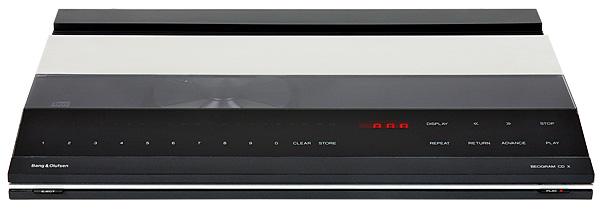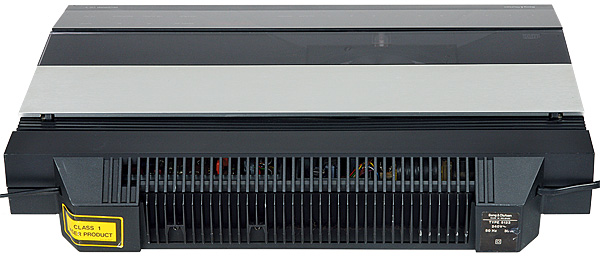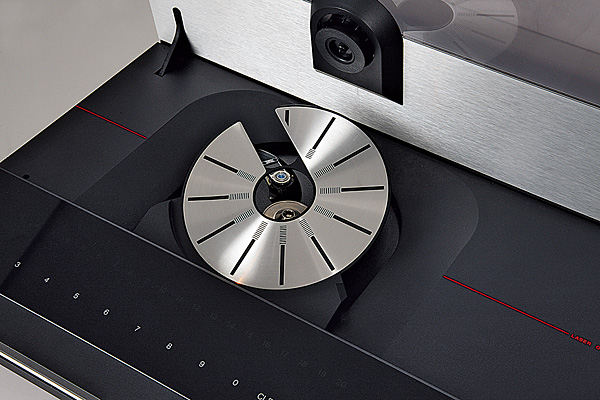B&O Beogram CD X

 With components sourced from Dutch giant Philips, does this slick-looking CD player from 1986 still represent the 'last word' in 14-bit sound? We take it to the test bench
With components sourced from Dutch giant Philips, does this slick-looking CD player from 1986 still represent the 'last word' in 14-bit sound? We take it to the test bench
The step change in technology that came with the introduction of CD was too great for all but the largest hi-fi manufacturers to handle alone. As a result, those that lacked the resources to design and produce their own machines had instead to buy completed assemblies from either Philips or one of the larger Japanese brands.
Bang & Olufsen was unusual in this respect in that it turned to two companies for components when designing its first range of CD players: Aiwa for the Beogram CD50 [HFN May '15] and Philips for the Beogram CD X we have here.

Not Just A Bit Player
B&O's strategy at the time was to sell complete systems, each comprising units whose cost, appearance and technical performance were matched. The CD50 was designed to be used with the Beosystem 5000 and was styled to complement it perfectly. The CD X, on the other hand, was for everything else, both old and current.
Released in 1986, the CD X was initially viewed as relatively conservative due to its use of 14-bit architecture when Philips had already moved on to 16-bit processing with the CD450 [HFN Aug '14]. The CD X, on the other hand, was built using an earlier group of components, the servo and decoder printed circuits (as Philips referred to them) and the CDM 1 transport being those used for Philips' CD104 [HFN Apr '14]. Going back even further, the aluminium chassis casting had first been used in the original Philips CD100 model [HFN Oct '11]. Although the complete machine was produced in a Philips factory in Belgium there was never an equivalent Philips model to the CD X, nor was the same package ever sold to another manufacturer. It can therefore be considered a B&O original. What's more, the use of well tried and well regarded technology assured reliability and high levels of performance – the 14-bit Philips machines had been considered the ones to beat in the early days of CD.
Near Magical
Although conventional inside, the outer appearance of the Beogram CD X set it apart from all other CD players. Ignoring the drawer-loading black box format that was rapidly becoming the norm, B&O went for a powered top-loading arrangement. On command, the aluminium and clear plastic lid swung upwards under motor power after which a small disc-shaped tray, bathed in light from a concealed lamp, raised itself into position to accept the disc. The process reversed itself once the machine was instructed to play but the disc remained visible at all times.

Not content with this near-magical feat, B&O also made nearly all the controls of the CD X touch sensitive, using a proprietary technique first seen in the Beomaster 1900 receiver some ten years previously. This had used touch pads where the user's finger was detected by the disruption it caused to a small high frequency electric field. Originally the pads had been indentations in plastic but the CD X introduced a new medium – glass. Such things are commonplace today, but in 1986 the effect was astounding, the lightest pressure on the unyielding and unbroken surface instantly engaging the chosen function, positively and unerringly.
Traditional touch-sensitive switches could be upset by a build up of dirt or by the static charge being carried by the user, but B&O's 'Sensi-Touch' arrangement was immune to both these things. Later the glass panel technique would be used across the range, but the CD X was the first model to employ it.
Of the models current when the CD X was launched, perhaps the most relevant to it was the Beomaster 3000 receiver. The CD X looked broadly similar to the Beogram 3000 turntable, which matched this receiver and continued the theme of a red line running through the under-lid section. Within this, the CD X included the words 'Laser Optical Turntable', which goes to show how confusing CD technology could be in those early days. The CD X was also a good match for the Beomaster 6000 tuner/amplifier. Both this and the Beomaster 3000 had RCA inputs for a second tape recorder into which the CD X could be directly connected.

Older models lacked these inputs, so B&O made available a useful little device called a CD/Tape adapter. This fitted neatly under the overhang at one side of the CD X and allowed the player to share a cassette deck input with an existing recorder. Cleverly designed, it allowed CD-to-cassette transcription and even took into account the differing DIN and line-level sensitivities used by B&O cassette decks over the years.
The CD X was available until 1988, when it was replaced by the CD X II. Similar in appearance, this version used the Philips OEM 16-bit package and CDM2 transport, still mounted on the old CD100 chassis. The need for a standalone B&O CD player had been largely met by this stage and the CD X II was not as popular as the first. But it did sell well in modified form as the Beogram CD3300, the matching CD unit for B&O's 3300 system.
Ergonomic Quirks
Using the CD X today is still a wonder and a pleasure, the endless modern touch-screen appliances having failed to dull its impact. Unlike many other B&O components, connecting the CD X to units from other makers is simple as the output comes via a tethered lead having standard RCA plugs on the end. The output level is close to the nominal 2V standard, as one would expect from a Philips design [see PM's Lab Report].
There are one or two ergonomic quirks, however. The power switch, for example, is also marked 'play' because playback starts as soon as the machine is switched on if there is a disc loaded. Meanwhile, opening the lid is easy once one locates the slim 'eject' button, but closing it is another matter. This can either be done manually by pushing it down a little (which is not recommended) or by touching the 'play' legend. Pressing and holding 'stop' has the same effect if one does not want the music to start right away.























































